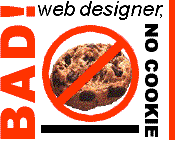|
|

The explosion in web publishing during the last few years has become a cliche of journalism. So has the growing use of tricks from the graphic designer's handbook to dress up commercial sites. It's pointed out less often that this explosion has been accompanied by the rise of hideously bad design. 800-pixel-wide tables. Graphics that take minutes to download. Graphics with no alt text. Swaths of text presented in nearly-unreadable-on-screen 12-point Helvetica. Multi-scrolling frames. Unscrollable frames with hardcoded widths, forsooth. Pages with background music, a wonderful interruption when you're already listening to a CD. The list goes on.
And things aren't getting better as time goes by and browsers acquire more features. In fact, they're getting worse. Site after site proudly rolls out a "redesign" - often created by a professional graphic artist - that replaces better (if simpler) pages with worse, making their site more sluggish and less usable for all.
That's bad enough in itself, but the long-term consequences for the web are much more dire than the possibility that you'll drive annoyed visitors away from your site. Too many pages these days are "coded for both browsers: Netscape and Explorer", sibling browsers that are both based on Mosaic, that take an almost-identical approach to HTML, and that share almost every flaw - from ugly default colors to the presentation of <h6> in a small font despite the fact that it's supposed to be a heading - with that aboriginal browser.
A personal computer with a large color screen is not the only environment in which thoughtfully-designed HTML can be presented. As a structured method of information design, HTML lends itself to text-only browsers, spoken-word browsers, and fully graphical browsers, with information coming to the visitor by means of anything from a cellular phone to a television screen to a palmtop note-taker. The universe of the Web, then, is potentially much wider than "all recent-model desktop computers running Netscape or Mosaic".
But slowly but surely, the web is giving up that potential, as pages lose the flexibility to be viewed with anything but Mosaic and its children. (Many pages can't even be viewed easily with the Terrible Two, if the visitor has had the temerity to set preferences other than those assumed by the designer, or is using an older version.) In such an environment, what chance do innovative new ways of browsing the web have to catch on? If much of the web is designed so that it simply can't be used with anything but Netscape and Explorer, the future of the web will be effectively limited to just one method of browsing - and web designers will have helped to permanently enshrine that limit.
It's also worth remembering that if a text-mode browser can't make sense of your page, neither can a search engine's spider. Today's web-searching tools are relatively crude, but even the robots used by search engines rely on the page's underlying information structure, and will have predictable problems if the designer obscured that information structure in trying to do page layout. There are people thinking about other sorts of presentation and summary - for example, a tool to gather and index all the quotations in the web, or a browser that creates outline views of a site using the <h1>...<h6> header tags. But again, it all relies on the integrity of the abstract information structure, the spine of the web page.
The strength of HTML, as a publishing medium, is its infinite flexibility. If you publish a book, a paper, or a brochure in well-written HTML, you get the large-type edition (and the spoken edition, and the edition people can look up on their Newton screen, and the edition they can check at a text-only Internet kiosk while traveling) for free. When you design for a single browser and a single browsing situation, you lose that flexibility. And so does the web.